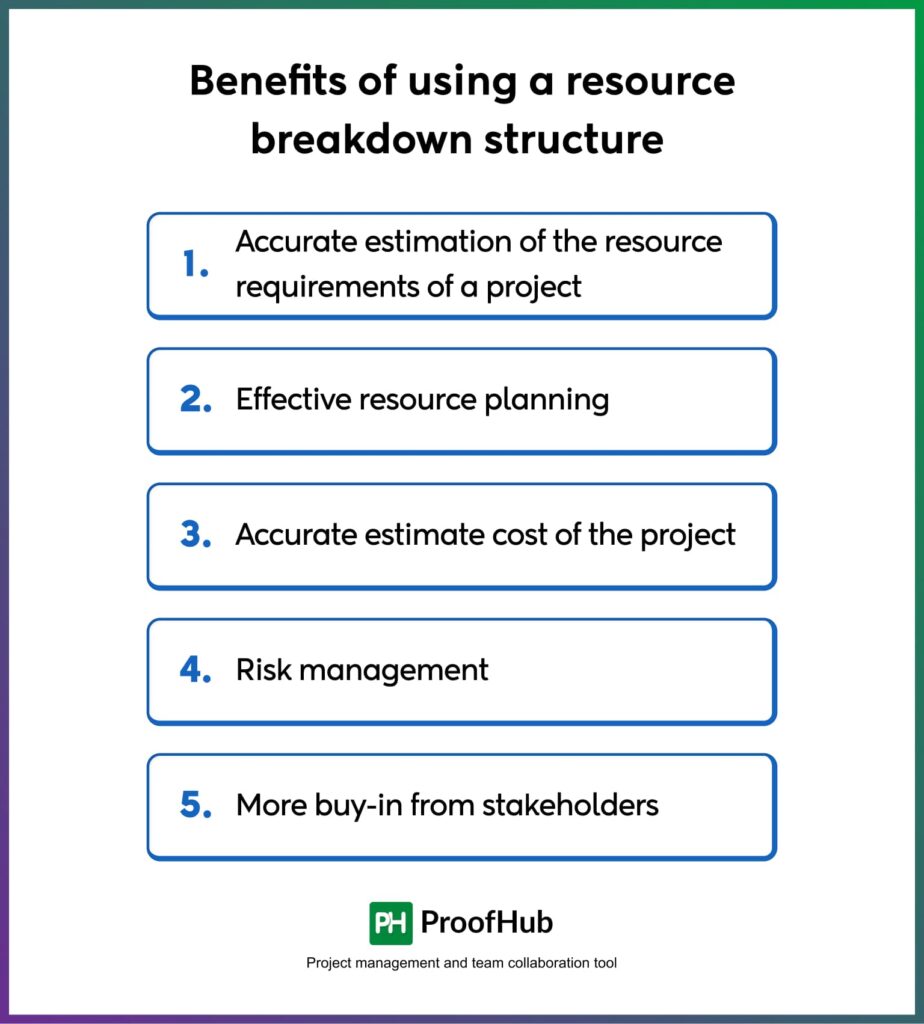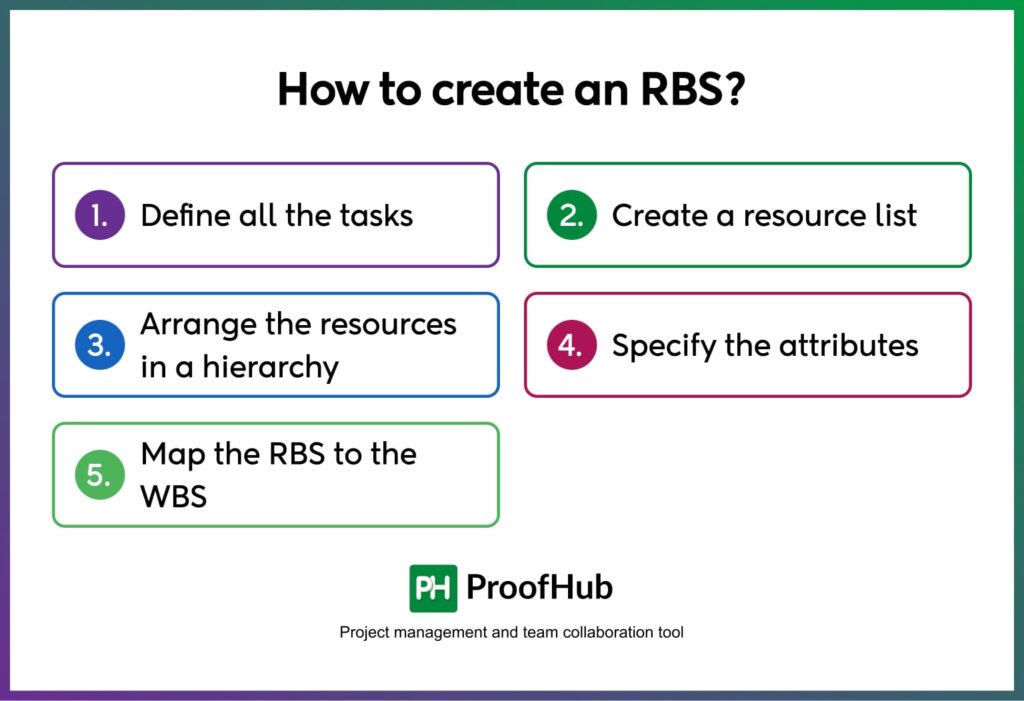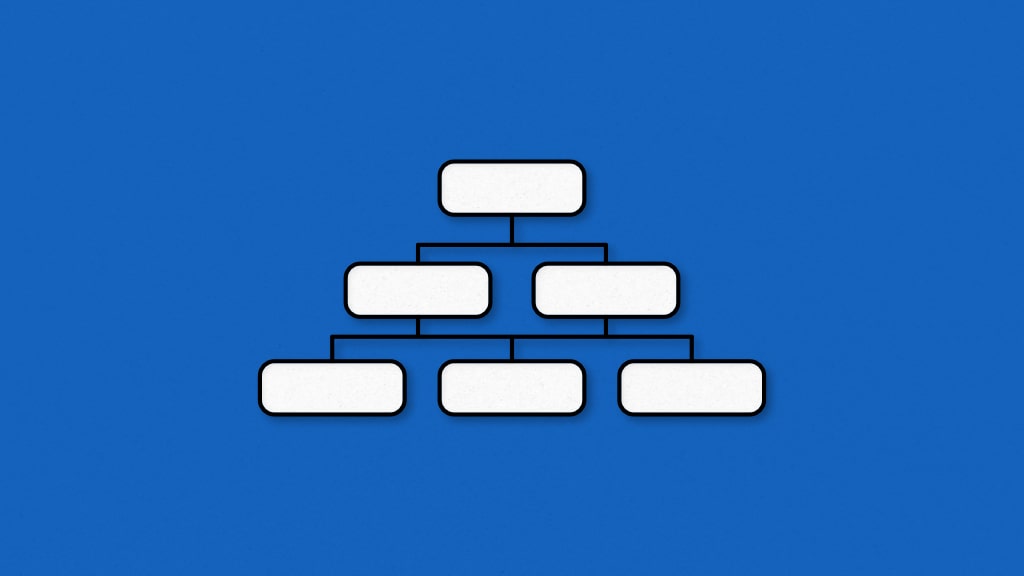Introduction
Resource breakdown structure (RBS) is a method for project resource planning that helps a manager outline all the resources needed to complete a task in a project. The purpose of creating an RBS is to ensure sufficient resources for every task so that a project is completed on time.
Completing any task in a project requires certain types of resources such as people, equipment, technology, space, money, and time. Without these resources, team members find it difficult to complete tasks, leading to project failure.
RBS is created during the project’s planning stage to ensure the project team achieves the project objectives. In this post, we will discuss a resource breakdown structure, its importance, how to create an RBS for a project, and tips on implementing RBS in project management.
What is a resource breakdown structure in project management?
A resource breakdown structure in project management is a framework that uses a hierarchical structure to outline the resources needed for a project. Like a work breakdown structure (WBS) which focuses on tasks and deliverables, an RBS creates a detailed breakdown of resources for each task. Thus, a project manager can have a clear idea of ‘what’ resources are needed and ‘when’ for each project task.
This allows project managers to allocate, schedule, and track resources for effective resource planning of a project. Especially when resources are shared among multiple projects, it helps you to schedule the resources effectively based on availability.
A resource breakdown structure can be represented as a list with a further breakdown of subcategories on a spreadsheet, or using a diagram, or a Gantt chart. Usually, a project resource breakdown structure is limited to four levels. However, if required, PMI suggests that there can be up to 20 levels in a breakdown structure.
Benefits of using a resource breakdown structure
Creating a resource breakdown structure (RBS) for a project has many benefits. Have a look at them.

- Accurate estimation of the resource requirements of a project: The biggest benefit of an RBS is its ability to provide a precise estimation of resource needs. By organizing resources into a hierarchical structure with various categories, RBS enables you to identify and detail all resources required to perform each task. Having a comprehensive breakdown reduces the risk of errors and allows accurate forecasting of the resources necessary, ensuring that every aspect of the project is adequately covered.
- Effective resource planning: RBS includes assigning the attribute of time and money to the resources. The detailed breakdown aligned with the tasks outlined in the WBS helps in identifying the dependencies of project resources and scheduling. With the RBS, you can allocate resources as per their availability, ensuring that they are utilized efficiently throughout the project.
- Accurate estimate cost of the project: You can create an accurate estimate of the project cost in terms of time and cost. This clear representation facilitates precise project cost estimation. Alongside this, it also simplifies budgeting and financial planning, contributing to overall project expenses.
- Risk management: RBS can help in project risk management by providing a structured plan for resource allocation. It outlines when and in what quantity resources are needed, enabling you to monitor progress and address any shortages or delays. This foresight also helps mitigate risks related to the scarcity of resources and ensures that each task has the necessary resources at the right time of timely completion.
- More buy-in from stakeholders: With its transparent approach, the RBS can help you get more buy-in from critical stakeholders. By clearly showing how resources are allocated and explaining the reasons behind their use, RBS provides a clear understanding of resources. This helps in avoiding conflicts and facilitates smoother change management.
Read more: What is resource allocation? A step-by-step guide
How to create a resource breakdown structure?
Creating a resource breakdown structure is crucial for effective project management. There are two ways to create an RBS: by function or by type.
Creating an RBS by function: It includes a breakdown of the resources by the job function or category, such as managers, engineers, marketing executives, graphic designers, and content writers. This breakdown helps understand the resource requirements for a project.
Creating an RBS by type: It includes a breakdown of the resources by type, such as human resources, equipment, facilities, technology, and finances. This breakdown helps identify the specific needs and availability of different resource types.

We have explained how to create an ‘RBS by type’ in the following five simple steps:
1. Define all the tasks
The first step to creating an RBS is to list all the tasks you need to work on in a project. These tasks form the basis of the calculation of resource requirements.
A work breakdown structure can provide you with all the information about tasks in a project.
If you have not created a WBS, create it using the project scope first. The purpose is to collect all the project requirements from all the stakeholders to create an accurate RBS.
2. Create a resource list
Based on the task list, identify and list all the resources needed. This includes all resources, including people, equipment, space, and technology.
You can also add attributes of cost and time for each resource at this point if you are referring to them as financial resources. Otherwise, you can add them later as attributes while specifying other characteristics of each resource in Step 4.
You can use a resource breakdown structure template in an Excel spreadsheet, project management software, or content creation tool to list all the resources for each project task.
3. Group the resources and organize them in a hierarchy
After identifying all the resources, you must group them into various categories based on the type and create a further breakdown of resources.
Here is a step-by-step process of how to do it:
- Define the primary categories: First of all, group all the identified resources into four primary categories: human resources, equipment, physical resources, and technology. These categories form the first branch and second level of your RBS under the title, representing the top level.
- Create subcategories: Further, subdivide each primary category into 3-5 subcategories based on the function. For example, in the ‘human resource’ primary category, you might have subcategories like managers, engineers, marketing executives, designers, and content writers. These subcategories make the third level of your RBS.
- List down individual resources in each sub-category: Further breakdown each subcategory to list down the individual resources. For example, under the ‘content writer’ sub-category, you might include copywriter, blog writer, and technical writer. This is the most granular level of the RBS, where you specify attributes for each resource.
4. Specify the attributes
This is the step where you quantify the resource requirements. For each identified resource, start specifying the attributes like cost, availability, and name. This will help you estimate resources accurately.
For example, specifying attributes for the ‘human resource’ category at an individual level under the sub-category ‘content writers’ can look something like this:
- Technical writer: Jones, Availability full-time, $60/hour
- Copywriter: Martha, Availability half-day, 50%, $50/hour
- Blog writer: Adam, Availability, 6 hours 75%, $40/hour
For equipment:
- Laptop: Laptop A, Leased for $X, specifications, entire project duration
- Printer: Printer A, Leased for $Y for four weeks
- Camera: Camera 1, Leased for $Z for two weeks
For technology:
- Project management software: Premium account, $X for 7 users
You can add additional attributes as per your project requirements.
5. Map the RBS to the WBS
Finally, the identified resources should be aligned with each task outlined in the WBS. This helps ensure each task has the necessary resources for effective resource planning.
Read more: The project management triangle – All you need to know
Example of resource breakdown structure
Let’s understand a project’s sample resource breakdown structure with an example of a product launch marketing campaign.
Here is the list of resources you need, categorized into four primary categories:
1. Human resources
1.1) Management
- Product Marketing Manager
- Marketing Manager
- Sales Manager
1.2) Digital marketing executives
- SEO Specialist
- Social Media Executive
- Email Marketing Specialist
1.3) Content creators
- Copywriter
- Blog Writer
- Video Producer
1.4) Design team
- Graphic Designer
- Video Editor
1.5) Sales & PR
- Sales Representatives
- PR Specialist
2. Equipment & materials
- Computers
- Testing devices
- Cameras
- Printers
- Marketing Collateral (product brochures, flyers, giveaways)
- Event Materials (banners, displays, signage)
The detailed breakdown for the ‘computer’ subcategory can include the types of computers you need and quantity, such as Mac x 3, Windows x4, and Linux x3.
Do this for every resource subcategory.
3. Space
- Office space
- Meeting rooms
- Video shooting room
- Launch venue
Define the details and name of the space and when you need it.
4. Technological resources
- Content management system
- Marketing automation tools
- Analytics tools
- Email marketing platforms
- Video editing software
- Project management tools
- Content creation tools
Add the attributes such as quantities, suppliers, cost, time, and roles to individual resources in each category to create an effective RBS.
Similarly, you can create a resource breakdown structure for construction, IT, or any other project with a clear scope.
Read more: 2025 Guide to project resource management: Processes, challenges & tools
What is the difference between RBS and WBS?
RBS and WBS are project planning tools based on the same principle of hierarchical decomposition to simplify complex projects, but they serve different purposes. The former provides the detailed breakdown of the resources of a project and the latter provides the detailed breakdown of the project’s tasks.
A WBS should be created before the RBS because the design and structure of the RBS depend on the WBS, and it is created based on the tasks listed in the WBS.
Resource breakdown structure, “An RBS describes the project’s resource organization and can be used in conjunction with the WBS to define work package assignments.”
Resource breakdown structure is an officially recognized tool. That’s why it is included in the PMP certification exam training.
Many people also mistake RBS for the inventory lists that include all the resources required by a project team. Still, it is different from the inventory list in the fact that RBS helps in strategic planning, accurate forecast of resource needs, and efficient allocation of resources for the project lifecycle with a hierarchical breakdown of project resources.
Who is responsible for creating an RBS?
In most cases, a project manager is responsible for creating an RBS. However, companies with large-scale and complex projects might have a dedicated resource manager to handle this task.
Regardless of who creates the RBS, inputs from other project stakeholders, such as clients, end-users, a project team, and vendors, are required to create an effective RBS. Without collecting requirements from all the stakeholders, you cannot define the project scope comprehensively, map out the resource dependencies, and identify the risks, leading to poor resource planning.
Read more: Key project manager roles and responsibilities
Tips for creating and implementing RBS in project management
Have a look at some tips that can help you create an effective RBS and implement it in project management.
1. Mirror the design of your WBS when creating a RBS for your project
WBS and RBS are the two project planning tools that go hand-in-hand. One provides you with a detailed hierarchical decomposition of all the tasks in a project, while the other provides a breakdown of all the resources required. For effective resource allocation, you should match your RBS with WBS.
2. Use standard format for nomenclature
To create an accurate RBS, it is very important to use a standard format for nomenclature. Here is an example of the most widely used format:
1. Human resources
1.1. Manager
1.1.1. Marketing manager
1.1.2. Product manager
1.1.3. Sales manager
1.2. Content Writer
1.2.1. Copywriter
1.2.2. Content writer
1.2.3. Technical writer
2. Equipment
2.1 Computer
2.1.1. Computer 1 MAC
2.1.2. Computer 2 Windows
2.1.3. Computer 3 Linux
2.2 Testing device
2.2.1. Android smartphone
2.2.2. iOS smartphone
2.2.3. Tablet
3. Collaborate with all the stakeholders right from the beginning
One of the major reasons for poor resource planning and inaccurate risk assessment is the lack of collaboration among stakeholders during the planning stage to calculate all the project requirements. Therefore, it is very important to involve all the project stakeholders while defining the project scope and assessing all the risks. It helps you create an effective resource plan and allocate sufficient buffer time and contingency funds to manage risks.
4. Use a project management software to implement an RBS in a project
The best way to implement an RBS in a project is to use project management software. A project management software helps you visualize the RBS on a Gantt chart. You can see how each resource is allocated to the tasks in a project, visualize the dependencies, and track the progress of each resource. This enhanced visibility and alignment of RBS to the project plan helps you ensure resources are provided to the team members on time and manage risks effectively.
5. Review and refine
Project requirements rarely remain the same as planned. Therefore, it is important to keep in mind that RBS is not an absolute plan. It can be adapted to meet changing project needs and priorities. Continuously review the RBS and be flexible and willing to adjust to address any changes in resource availability or project scope.
Create and implement a resource breakdown structure for your project with ProofHub
ProofHub is an all-in-one project management and team collaboration software that can help you create a resource breakdown structure for a project with its comprehensive range of features.
Here is how you can create an RBS with ProofHub:
- Set up a project of creating an RBS, add team members to the project, and start collaborating using project discussions
- Use collaborative notes to identify the resource requirements for each task of the project or create a list of resources on a spreadsheet with subcategories and share it with all the team members using ProofHub’s centralized file-sharing
- Create all the tasks you need to complete in a project and use custom fields to enter the resource requirements of each task of the project
- View all the tasks along with their resource requirements on a Gantt chart and set dependencies of resources for a project. This will create a resource breakdown structure for a project aligned with tasks
Make changes as the project progresses using the Gantt chart and schedule resources as per the availability in the Calendar
FAQs
What is the purpose of a resource breakdown structure?
The purpose of a resource breakdown structure is to provide a detailed breakdown of all the resources required in a project so that every task in a project has sufficient resources to complete it on time. The eventual goal is the project’s success which is achieved by completing individual tasks timely.
Can RBS be used in Agile Project Management?
Yes, RBS can be used in Agile project management but iteratively. Rather than planning an RBS for the complete project simultaneously, create an RBS for the sprint. This will provide a stable framework for resource planning for the sprint while keeping the Agility intact by planning for short sprints iteratively.
How often should an RBS be reviewed and updated?
It depends on the project and risks. For projects with higher external and internal dependencies and dynamic environments, you may have to track the RBS regularly and review and update it as soon as a risk reaches a certain threshold limit. However, you can review and update requirements in installments for slow-moving projects with stable requirements.

